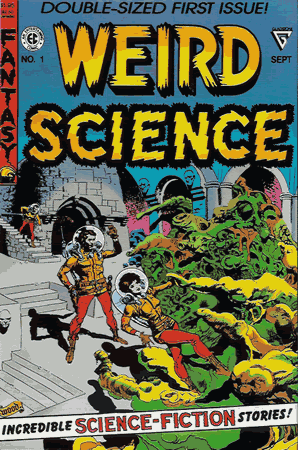 |
| For any gamer who doesn't think that Science Fantasy can work I offer this "simple " wood cover . Notice everything happening here! |
King of The Ring
Wally Wood is possibly the greatest comic book artist that ever picked up a pencil in my opinion. His career stretched from the 1940s through the 1980s. The man was a master & there isn't a single doubt in my mind. All of his science fiction art is jam packed with details. There isn't a square surface that doesn't have something for the eye to see but its not busy at all. That's the mark of a master where your simply drinking in the whole thing.
He worked for EC publishing in the 50s & did so much that I can't even begin to cover this man's work. I'll be covering the Thunder Agents another time.
EC publisher William Gaines once stated, "Wally may have been our most troubled artist... I'm not suggesting any connection, but he may have been our most brilliant".[2]
He was the inaugural inductee into the comic book industry's Jack Kirby Hall of Fame in 1989, and was posthumously inducted into the Will Eisner Comic Book Hall of Fame in 1992.
In addition to Wood's hundreds of comic book pages, he illustrated for books and magazineswhile also working in a variety of other areas — advertising; packaging and product illustrations; gag cartoons; record album covers; posters; syndicated comic strips; andtrading cards, including work on Topps' landmark Mars Attacks set.Wood & The OSR
A Dungeon Master may learn something from Woody Wood (Within the comics community, he was also known as Woody, a name he sometimes used as a signature).From what are known as the 22 panels which were drilled into my head in college! From Wiki -Wood struggled to to be as efficient as possible in his often low-paying work-for-hire.[18] Over time he created a series of layout techniques sketched on pieces of paper which he taped up near his drawing table. These 22 "visual notes," collected on three pages,[19] reminded Wood (and select assistants he showed the pages to)[20] of various layouts and compositional techniques to keep his pages dynamic and interesting.[18] (In the same vein, Wood also taped up another note to himself: "Never draw anything you can copy, never copy anything you can trace, never trace anything you can cut out and paste up.")[19]
Years later, in 1980 or 1981,[19] Wood's ex-assistant Larry Hama, by then an editor at Marvel Comics, collected Wood's drawings and had them pasted-up on a single page, which Hama titled "Wally Wood's 22 Panels That Always Work!!" (It was subtitled, "Or some interesting ways to get some variety into those boring panels where some dumb writer has a bunch of lame characters sitting around and talking for page after page!") Hama distributed Wood's "elegantly simple primer to basic storytelling"[21] to artists in the Marvel bullpen, who in turn passed them on to their friends and associates.[20] Eventually, "22 Panels" made the rounds of just about every cartoonist or aspiring comic book artist in the industry and achieved its own iconic status.[21]
Homages and tributes to "22 Panels"
In 2006, writer/artist Joel Johnson bought the original paste-up at auction and made it available for wide distribution on the Internet.[20] In 2010 Anne Lukeman of Kill Vampire Lincoln Productions produced a short film adapting the "22 Panels That Always Work" into a film noir-style experimental piece called 22 Frames That Always Work.[22] Artist Rafael Kayanan created a revised version of "22 Panels" that used actual art from published Wood comics to illustrate each frame.[23] In 2011, cartoonist D.J. Coffman had all 22 panels tattooed onto his left arm.[24]
Personal life and final years
Wood was married three times. His first marriage was to artist Tatjana Wood, who later did extensive work as a comic-book colorist. Their marriage ended in the late 1960s.[3] His second marriage, to Marilyn Silver, also ended in divorce.[3]
For much of his adult life, Wood suffered from chronic, unexplainable headaches. In the 1970s, following bouts with alcoholism, Wood suffered from kidney failure.[3] A stroke in 1978 caused a loss of vision in one eye.[3] Faced with declining health and career prospects, he committedsuicide by gunshot in Los Angeles, California three years later.[3]
In 1972, EC editor Harvey Kurtzman, who worked closely with Wood during the 1950s, said:
Wally had a tension in him, an intensity that he locked away in an internal steam boiler. I think it ate away his insides, and the work really used him up. I think he delivered some of the finest work that was ever drawn, and I think it's to his credit that he put so much intensity into his work at great sacrifice to himself.[25]
I personally will always think of him as the one & only Wally Wood. Thanks & Happy Sunday










No comments:
Post a Comment
Note: Only a member of this blog may post a comment.